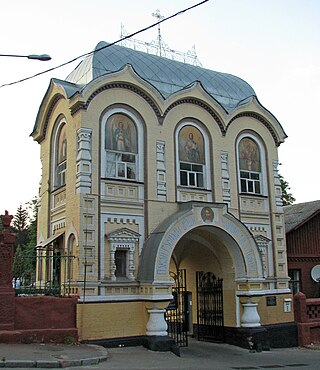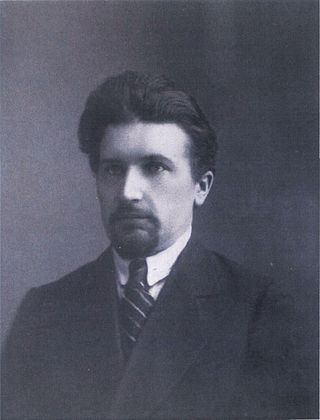This article needs additional citations for verification .(October 2021) |

This article needs additional citations for verification .(October 2021) |

The Military Cemetery was opened and consecrated in 1895 when a nearby older cemetery for military personnel was closed for further interments. In 1898, an Orthodox church was built in the cemetery – conceived as a monument to the soldiers who gave their lives in the Russo-Turkish war of 1877–1878. Inside the church there are plaques with the names of 118 Belarusians who perished recapturing the Bulgarian city of Pleven from the Turks.
in the interwar period the cemetery became the burial place of prominent statesmen, soldiers, scientists and people of creative professions.
Soviet authorities closed the church before World War II but during the German occupation services were resumed. After World War II the city authorities considered converting the church into a coffin workshop but the plans did not materialise and the church remained one of the few functioning places of worship in Soviet Minsk. [1] [2]
In 2018, improvements were announced by the city authorities and municipal workers began dismantling many fences and monuments, which were replaced by cheap concrete "headrests". Historians, restorers, and relatives of the buried argued that "the improvement is reminiscent of demolition," and called for the protection of the cemetery. The public initiative "Military Cemetery" was created, the participants of which improved the burials. After court proceedings brought by the descendants of the buried, the destruction of old graves stopped. However, the workers managed to "beautify" half of the cemetery and destroyed about 300 old tombstones. [3] [4]

Minsk is the capital and the largest city of Belarus, located on the Svislach and the now subterranean Niamiha rivers. As the capital, Minsk has a special administrative status in Belarus and is the administrative centre of Minsk Region and Minsk District. As of 2023, it has a population of two million, making Minsk the 11th-most populous city in Europe. Minsk is one of the administrative capitals of the Commonwealth of Independent States (CIS) and the Eurasian Economic Union (EAEU).

Tikhvin Cemetery is a historic cemetery in the centre of Saint Petersburg. It is part of the Alexander Nevsky Lavra, and is one of four cemeteries in the complex. Since 1932 it has been part of the State Museum of Urban Sculpture, which refers to it as the Necropolis of the Masters of Art.

Rasos Cemetery is the oldest and most famous cemetery in the city of Vilnius, Lithuania. It is named after the Rasos district where it is located. It is separated into two parts, the old and the new cemeteries, by a narrow Sukilėliai Street. The total area is 10.8 ha. Since 1990 new burials are allowed only to family graves.

Kobryn or Kobrin is a town in Brest Region, Belarus. It serves as the administrative center of Kobryn District. It is located in the southwestern corner of Belarus, where the Mukhavets river and Dnieper–Bug Canal meet. The town lies about 52 kilometres (32 mi) east of the city of Brest. As of 2023, it has a population of 52,670.

Olšany Cemeteries is the largest graveyard in Prague, Czech Republic, once laid out for as many as two million burials. The graveyard is particularly noted for its many remarkable Art Nouveau monuments.

Radasłaŭ Kazimiravič Astroŭski was a Byelorussian collaborator with Nazi Germany who served as president of the Belarusian Central Council, a puppet Belarusian administration under German hegemony from 1943–1944, and in exile from 1948-1976.

Belarusian culture is the product of a millennium of development under the impact of a number of diverse factors. These include the physical environment; the ethnographic background of Belarusians ; the paganism of the early settlers and their hosts; Eastern Orthodox Christianity as a link to the Byzantine literary and cultural traditions; the country's lack of natural borders; the flow of rivers toward both the Black Sea and the Baltic Sea; and the variety of religions in the region.

Zianon Stanislavavič Pazniak is a Belarusian nationalist politician, one of the founders of the Belarusian Popular Front and leader of the Conservative Christian Party – BPF. He was the Belarusian Popular Front nominee for President of Belarus in the 1994 election.

The Glasgow Necropolis is a Victorian cemetery in Glasgow, Scotland. It is on a low but very prominent hill to the east of Glasgow Cathedral. Fifty thousand individuals have been buried here. Typical for the period, only a small percentage are named on monuments and not every grave has a stone. Approximately 3,500 monuments exist here.

Dinamo National Olympic Stadium is a multi-purpose stadium in Minsk, Belarus. It was reopened after a renovation project. Earlier it was used mostly for football matches and was the home ground of Dinamo Minsk, FC Minsk and the Belarus national football team. Previously the stadium officially held 40,000, but because part of the upper stand had been abandoned in the mid-1990s for safety reasons, the actual capacity before renovations was 34,000. After renovation the capacity is only 22,246.

Antakalnis Cemetery, sometimes referred as Antakalnis Military Cemetery, is an active cemetery in the Antakalnis district of Vilnius, Lithuania. It was established in 1809.

Samuil Jafimavič Płaŭnik, better known by the pen name Źmitrok Biadula, was a Soviet and Belarusian poet, prose writer, translator, and political activist in the Belarusian independence movement. He is considered one of the fathers of modern Belarusian literature.

Baikove Cemetery is a historic cemetery memorial in Holosiiv Raion of Kyiv, Ukraine. It is a National Historic Landmark of Ukraine and is known as a necropolis of distinguished people.

The National Art Museum of the Republic of Belarus is the largest art museum in Belarus and is located in its capital, Minsk. The museum comprises more than thirty thousands works of art which make up twenty various collections and constitutes two main ones: the one of national art and the other of art monuments of various countries of the world.

Soviet repression in Belarus refers to cases of persecution of people in Belarus under Soviet rule.

Archmandrite Andrei Tsikota MIC was a Belarusian Roman Catholic and Greek Catholic priest, Superior General of the Congregation of Marian Fathers of the Immaculate Conception, Ordinary of the Russian Catholic Apostolic Exarchate of Harbin, member of the Rada of the Belarusian Democratic Republic.
Jazep Jucho was a prominent Belarusian lawyer, historian and writer and a leading Belarusian authority on the laws of the Grand Duchy of Lithuania.

ArkadźSmolič was an academic, active participant of the Belarusian independence movement and a victim of Stalin's purges.

Usievalad Ihnatoŭski was a Belarusian politician, scholar and the first president of the National Academy of Sciences of Belarus.